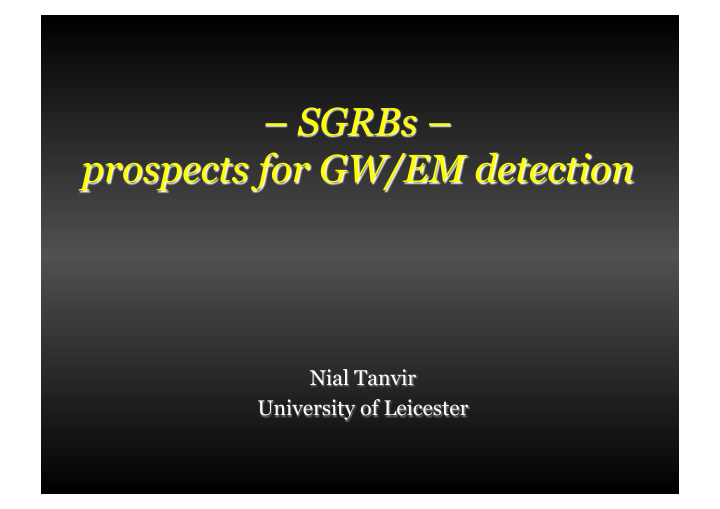



• Swift detects only about 5-10 per year. • In a few cases, even a prompt slew fails to give an X-ray detection, or perhaps a very marginal one (~10-15%; but many of these are amongst the most unambiguously short events!). • In cases where an X-ray position is found, sometimes an accompanying optical afterglow has also been found, but often they have been faint (ie. Sometimes fairly rapid 4-10 m telescope followup insufficient). • Only ~3 SGRBs seem to have early-type (non star-forming) hosts. • The redshifts we have are essentially all from the putative host galaxy (a couple of exceptions to this are probably not normal SGRBs) • They seem to be a heterogeneous class (combined, perhaps, with being an ill- defined class). For example, some have durations making them difficult to put in one camp or the other (e.g. 1<T90<4s). Some have low level, soft extended emission lasting perhaps minutes. Beaming poorly constrained. • Theoretically, may expect there could be at least several different progenitors e.g. NS-NS (leading to either magnetar or BH), NS-BH, SGR giant flare.
Typically afterglows very faint and/or fade fast in optical/IR. Rapid response from very large aperture telescope may be key (e.g. to get absorption redshifts, to search for accompanying faint SN-like events). e.g. GRB090515 afterglow R~26.5 at 2 hours post burst. No host. Very tough for 8 m, but good target for ELT spectroscopy. Rowlinson et al. 2010
Seem to be lower luminosity (hence lower <z>) and found in hosts with less ongoing star formation. But: Some afterglows too faint to give X-ray position No un-ambiguiously short burst yet with absorption redshift Some have no apparent host, so no definite redshift (hence rely on probabilistic arguments and assume progenitor kicked from host ) Fong et al. 2011 Berger 2011
Redshift distribution Still poorly constrained, but volume density apparently rather low. Eyles et al. 2007 GRB 080905A; Rowlinson et al. 2010 Metzger & Berger 2012
“Hostless” shorts Seem to be at comparable redshifts to the hosted population Eyles et al. 2007 Tunnicliffe et al. in prep
GRB 050509B Swift detected short duration (soft, faint) GRB, very close on sky to a z=0.22 cD galaxy in a galaxy cluster. No optical afterglow (Bloom et al. 2005, Gehrels et al. 2005) and no SN (Hjorth et al. 2005).
• T 90 ~2s (Most likely “short” according to Donaghy et al. 2006 ) • Faint (red) afterglow ( Levan et al. 2006 ), with SED best fit by a redshift z~4.5 ( de Ugarte Postigo et al. 2006 ). • Also faint (R~27), red (R-H~4.5) host (likely z>2, possibly z>4?) • Fluence ~ 7x10 -6 erg/cm 2 , so very energetic if at these redshifts! • cf. GRB000301c – Jensen et al. 2001 – a T 90 ~2s assumed long burst.
High-z SGRBs - a distinct population? • Argued by Berger et al. (2006) • Beware that in some cases the identification of the host is ambiguous - in particular, if NS-NS systems can have large kicks and slow in-spiral times, then various galaxies a wide range of redshifts could be the host in some cases. (cf. Bloom et al. 2006)
• One class of apparently short duration bursts is characterised by a long “tail” of soft X-ray emission. • T90 can formally therefore be long. Perley et al. 2009
Initial pulse very short, extended emission particularly bright ( Perley et al. 2009 )
• Soft gamma repeaters are thought to be highly magnetised (young) neutron stars which occasionally emit violent high energy flares due to large scale reconfiguration of their crust under magnetic stress. • These short, bright events would be seen as short-GRBs if they occured in nearby external galaxies.
Short Bursts & PSCz Galaxies Consider only BATSE bursts with <10 degree positional uncertainty. Sbc and earlier type galaxies All galaxies Long bursts Tanvir et al. 2005 Conclude 10-25% of BATSE S-GRBs within ~100 Mpc
GRB 051103 was a bright short burst, identified by the IPN system. It’s (long thin) error box overlaps with part of the disk of M81 (at about 3.5 Mpc) and possibly extends as far as M82. Deep search reveals no afterglow, and spectroscopy inconclusive. Hurley, Rowlinson et al. 2010
GRB 070201 was a very intense short burst (Golenetskii et al. 2007), identified by the IPN system, which overlapped with the outskirts of M31! (Hurley et al.) Statistically impressive: initially much longer error box noted to pass close to M31 (Perley and Bloom 2007), confirmed by subsequent refinement. Best candidate for an extragalactic SGR giant flare? (Fredericks et al. 2007)
GRB 050906 - a faint, short- duration burst (detected by Swift/BAT, undetected by XRT), but within the error box is a nearby galaxy IC 328 (v=9000 km/s ie. ~130 Mpc). Chance of such a galaxy in a random BAT error circle is <1%, so a candidate for a low-z short burst ( Levan et al. 2008 ).
Recommend
More recommend